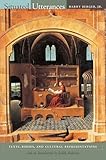Situated Utterances : Texts, Bodies, and Cultural Representations / Harry Berger.
Material type: TextPublisher: New York, NY : Fordham University Press, [2022]Copyright date: ©2005Description: 1 online resource (396 p.)Content type:
TextPublisher: New York, NY : Fordham University Press, [2022]Copyright date: ©2005Description: 1 online resource (396 p.)Content type: - 9780823224296
- 9780823292592
- online - DeGruyter
| Item type | Current library | Call number | URL | Status | Notes | Barcode | |
|---|---|---|---|---|---|---|---|
 eBook
eBook
|
Biblioteca "Angelicum" Pont. Univ. S.Tommaso d'Aquino Nuvola online | online - DeGruyter (Browse shelf(Opens below)) | Online access | Not for loan (Accesso limitato) | Accesso per gli utenti autorizzati / Access for authorized users | (dgr)9780823292592 |
Browsing Biblioteca "Angelicum" Pont. Univ. S.Tommaso d'Aquino shelves, Shelving location: Nuvola online Close shelf browser (Hides shelf browser)

|

|

|

|

|

|

|
||
| online - DeGruyter Secrets of Becoming : Negotiating Whitehead, Deleuze, and Butler / | online - DeGruyter Seducing Augustine : Bodies, Desires, Confessions / | online - DeGruyter Shakespeare and Donne : Generic Hybrids and the Cultural Imaginary / | online - DeGruyter Situated Utterances : Texts, Bodies, and Cultural Representations / | online - DeGruyter Sounding/Silence : Martin Heidegger at the Limits of Poetics / | online - DeGruyter Speaking of Music : Addressing the Sonorous / | online - DeGruyter Speaking the Truth in Love : Theological and Spiritual Exhortations of Ecumenical Patriarch Bartholomew / |
Frontmatter -- Contents -- Introduction -- Part one. Situating Utterance -- One. The Interpretive Shuttle: The Structure of Critical Practice after World War II -- Two. Bodies and Texts -- Part two. Situating Agency: Texts against Countertexts -- Three. The Origins of Bucolic Representation: Disenchantment and Revision in Theocritus’s Seventh Idyll -- Four. Narrative as Rhetoric in The Faerie Queene -- Five. The Pepys Show: Ghostwriting and Documentary Desire in The Diary -- Part three. Situating History: Contexts as Countertexts -- Six. From Body to Cosmos: The Dynamics of Representation in Precapitalist Society -- Seven. The Lie of the Land: The Text beyond Canaan -- Eight. Social Structure as Doom: The Limits of Heroism in Beowulf -- Nine. Fiction and Facticity: Reflections on Christian Nudity -- Part four. Situating Socrates: The Sublation of Socratic Utterance in Plato’s Dialogues -- Ten. Facing Sophists: Socrates’ Charismatic Bondage in Protagoras -- Eleven. Phaedrus and the Politics of Inscription -- Twelve. The Athenian Terrorist: Plato’s Portrait of Critias -- Part five. Conclusion: Situating Interpretation -- Thirteen. Making Interpretation Manageable: An Eight-Step Program -- Notes -- Index
restricted access online access with authorization star
http://purl.org/coar/access_right/c_16ec
Berger describes himself as “a reconstructed old New Critic,” and his publications over the past fifty years have centered on investigations of the ways in which texts represent both themselves and their situations of utterance. The thirteen chapters of the present book illustrate the range of his inquiry across several cultures and disciplines. They also demonstrate the interpretive richness, the theoretical acumen, and the energetic prose that characterize the work of one of America’s premier “close readers.” Situated Utterances is divided into four parts. In Part One Berger designs an analytical model of New Criticism and shows how it was dismantled during the decades after the Second World War. He then proposes a reconstructed model in which the practice of ironic and suspicious “close reading” may be directed toward interactions among bodies, texts, and countertexts in different cultural settings. Part Two demonstrates this practice in studies of specific works in three genres: the pastoral Idylls of Theocritus, Edmund Spenser’s epic, The Faerie Queene, and the Diaries of Samuel Pepys. The scope of the practice is broadened in Part Three to the connection between cultural representations and institutional change, a connection explored in four chapters that successively examine precapitalist forms of representation, the Old Testament, Beowulf, and the conflict between nakedness and nudity in Christian conceptions of the body. Part Four consists in three chapters on Plato’s dialogues, which Berger interprets as critical of the general situation of utterance in a predominantly oral culture. He argues that Plato uses the resources of writing to depict the heroic pathos of a Socrates whose method and message are defeated by the politics of the oral medium. Situated Utterances concludes with “A Conspectus of Critical Moves: The Eleven-Step Program.” This is a summary account of the interpretive strategies put into play by the author throughout his long career.
Mode of access: Internet via World Wide Web.
In English.
Description based on online resource; title from PDF title page (publisher's Web site, viewed 03. Jan 2023)


